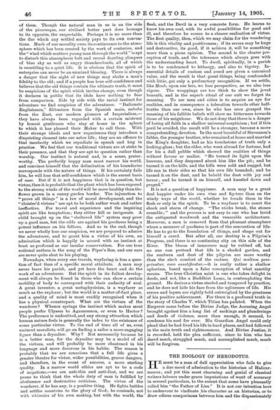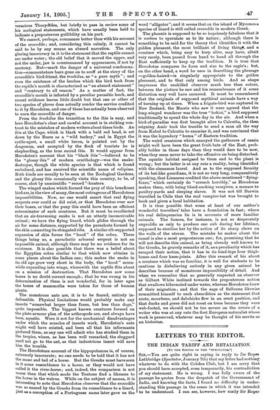H E must be a man of dull appreciation who fails
to give a due weed of admiration to the historian of Halicar- nassus ; and yet this most charming and genial of classical writers labours under grave imputations of want of accuracy in several particulars, to the extent that some have pleasantly called him " the Father of Lies." It is not our intention here to endeavour to vindicate his character as an historian, or to draw odious comparisons between him and the dispassionately
veracious Thucydides, but briefly to pass in review some of his zoological statements, which have usually been held to indicate a preposterous gullibility on his part.
We cannot, perhaps, commence better than with his account of the crocodile ; and, considering this calmly, it cannot be said to be by any means an absurd narration. The only glaring inaccuracy in it is the statement that the reptile cannot see under water; the old belief that it moved the upper, and not the under, jaw is countenanced by appearances, if not by anatomy. But—mark the danger of a universal condemna- tion—commentators have gone on to scoff at the story of the
crocodile's bird-friend, the trochilus, as "a pure myth " ; and
even the existence of the leeches which the bird took from the reptile's mouth is characterised as " an absurd statement" and "contrary to all reason." As a matter of fact, the crocodile's mouth is infested by a peculiar parasitic leech, and recent evidence leaves little doubt but that one or other of
two species of plover does actually, render the service credited to it by Herodotus, and one of these has actually been observed to warn the crocodile of danger.
From the trochilus the transition to the ibis is easy, and here Herodotus's clear and careful account is in striking con- trast to the mistakes of modern writers about these birds. An ibis at the Cape, which is black with a bald red head, is set down by the Boers as a "wild turkey," and in Egypt the cattle-egret, a small white heron, is pointed out by the dragoman, and accepted by the flock of tourists he is shepherding, as the true sacred ibis. It would appear from Herodotns's account that his " black ibis "—believed to be the "glossy ibis" of modern ornithology—was the snake- destroyer, though the white species is that which is found embalmed, and has received the scientific name of religiosa. Both kinds are usually to be seen at the Zoological Gardens, and the glossy ibis occasionally visits this country, to be, of course, shot by unscientific " record "-hunters.
The winged snakes which formed the prey of this beneficent bird are, in the view of many, the most outrageous of Herodotean impossibilities. Now, no one would assert that real flying serpents ever could or did exist, or that Herodotus ever saw their bones, or that the puny ibis could have been an efficient exterminator of such creatures. But it must be recollected that an air-traversing snake is not an utterly inconceivable animal; we have the flying lizard, which glides through the air for some distance, supported by the parachute formed by the skin connecting its elongated ribs. A similar rib-supported expansion of skin forma the " hood " of the cobra. These things being so, a parachutic arboreal serpent is not an impossible animal, although there may be no evidence for its existence. It is also possible that there was a belief about the Egyptian cobra similar to that which now obtains in some places about the Indian one; this makes the snake in its old age grow very short in the body, the " hood " mean- while expanding into wings, wherewith the reptile flits about on a mission of destruction. That Herodotus saw some bones is no doubt correct enough ; that he was wrong in his determination of them is not wonderful, for in later ages the bones of mammoths were taken for those of human giants.
The monstrous ants are, it is to be feared, entirely in- defensible. Physical limitations would probably make any insects "somewhat larger than foxes, but less than dogs," quite impossible. The biggest known creatures formed on the plate-armour plan of the arthropods are, and always have been, aquatic. Were it not for the mechanical disadvantages under which the muscles of insects work, Herodotus's ants might well have existed, and been all that his informants pictured them, as any one will admit who has studied them in the tropics, where, as has been well remarked, the sluggard need not go to the ant, as that industrious insect will save him the trouble.
The Herodotean account of the hippopotamus is, of course, extremely inaccurate; no one needs to be told that it has not the mane and tail of a horse. But the Greeks must have seen in it some resemblance to a horse, or they would not have called it the river-horse; and, indeed, the comparison is not
worse than that which made the Teutons find a likeness to the horse in the walrus. While on the subject of names, it is interesting to note that Herodotus observes that the crocodile was so named by the Greeks from its resemblance to a lizard, just as a corruption of a, Portuguese name later gave us the
word "alligator"; and it seems that on the island of Myconos a species of lizard is still called crocodile in modern Greek.
The phoenix is supposed to be so hopelessly fabulous that it is useless to speculate as, to its nature; although there is something to be said for the theory that identifies it with the golden pheasant, the most brilliant of living thing6, and a creature which, being easy to keep alive, may have, albeit very rarely, been passed from hand to hand all through the Eist sufficiently to keep up the tradition. It is true that Herodotus compares its form and size to the eagle's ; but, on the other hand, a word he uses in describing the plumage —golden-haired—is singularly appropriate to the golden pheasant, and to that only among birds. And as shape impresses the unskilled observer much less than colour, between the picture he saw and his remembrance of it some distortion may well have occurred. It must be remembered that the originals of supposed mythical animals have a way of turning up at times. When a frigate-bird was captured in New Zealand, the Maoris who saw it were agreed that the long-winged wanderer was the true " hokioi," a bird supposed traditionally to spend the whole day in the air. And when a bird-of-paradise was first brought alive to Calcutta, the then reigning Amir took the trouble to send a man all the way from Kabul to Calcutta to examine it, and was convinced that it was the legendary " huma " of Eastern tradition.
The weird creatures which annoyed the gatherers of cassia might well have been the great fruit-bate of the East, prob- ably bolder in those days than they would dare to be now, when they seem never to take the offensive on being disturbed. The aquatic, habitat assigned to them and to the plant is wrong ; but the latter is at any rate a reality, being identified with the cinnamon laurel. And as to the supposed ferocity of its bat-like guardians, it is not so very long, comparatively speaking, that Linnaeus credited the above-mentioned " flying- foxes," which certainly do "screech horribly," as Herodotus makes them, with being blood-sucking vampires, a menace to poultry-yards and sleeping slaves. It was not till Darwin travelled in Chile that the real vampire-bat was brought to book and given a local habitation.
It is thus possible that some at least of our author's wonderful travellers' tales have a foundation in fact; where his real delinquencies lie is in accounts of more familiar animals. The lioness, for instance, is not so desperately unprolific as only to produce one cub during her lifetime, supposed to sterilise her by the action of its sharp claws on the walls of the uterus. The mistake he makes about the camel is also a most preposterous one; for, premising that he will not describe this animal, as being already well known to the Greeks, he gravely remarks of it, as a peculiarity which has escaped their notice, that it has in its hind-legs four thigh- bones and four knee-joints. After this remark of his about a creature which was so familiar, it is well for students to be cautious in disbelieving entirely in any given animal he describes because of monstrous impossibility of detail. And when we remember that so generally respected an observer as Gilbert White inclined towards the preposterous notion that swallows hibernated under water, whereas Herodotus knew of their migration ; and that the sage of Selborne likewise committed himself to such absurdities as the statement that coots, moorhens, and dabchicks flew in an erect position, and that ducks and geese did not roost on trees because they were web-footed, we should not be too severe on the errors of a writer who was at any rate the first European naturalist whose work is preserved, whatever may be thought of his merits as an historian.







































 Previous page
Previous page